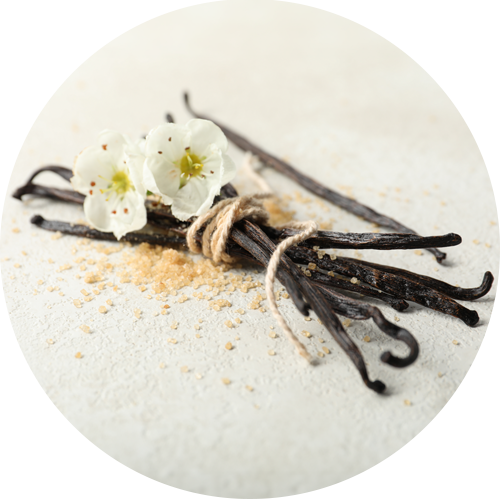Vanilla, a must-have flavor in thousands of sweet preparations such as biscuits, desserts, dairy products and others, is present in every kitchen in Latin America and the world. But it wasn’t always that way… do you know its origin?
Vanilla is the fruit of the only variety of edible orchids, a long climber that coils around trees in tropical forests, and can reach thirty-six meters long. The fruits of this plant are pods (vaina in Spanish), hence the origin of the name “vanilla”, which contains, among other aromatic substances, vanillin: principal contributor to vanilla’s aroma and flavor.
Vanilla is native to Mexico and northern Central America (Guatemala and Honduras). The Aztecs and Mayans used it, long before the arrival of Europeans to the continent, to flavour liqueurs and cocoa – food of the gods – which was given to nobles and warriors to drink. In the 16th century, Hernán Cortés brought vanilla pods to Europe to drink mixed with chocolate and, in a short time, it became popular in the Old Continent as an exceptional flavoring agent.
Although vanilla arrived in Europe in the 16th century, no one managed to produce the famous vanilla pod: the plants grew, but the fruits didn’t. It wasn’t until 1836 that Belgian botanist and horticulturist Charles François Antoine Morren traveled to Mexico to find out why vanilla pods couldn’t be produced in Europe. While he was there, he discovered that the problem was that the only insect capable of pollinating this orchid to bear fruit was the Melipona bee, from Mexico. Morren then developed an artificial method of fertilization (pollination) that allowed the pod to grow, ensuring a profitable vanilla industry in the French colonies. From then on, the cultivation and production of vanilla spread, reaching places as diverse and distant as Tahiti or Reunion Island.
Due to its laborious and complex cultivation techniques, vanilla is one of the most expensive spices, after saffron and cardamom. The most representative aromatic compounds of vanilla are vanillin and guaiacol, and they are distributed in different proportions depending on the type of vanilla.
Today only three species of the genus vanilla are grown industrially:
Vanilla planifolia
It accounts for 90% of global commercial production.
Known as Madagascar vanilla or Madagascar Bourbon vanilla, it is mainly grown in Madagascar, Mexico and Indonesia. It stands out thanks to its natural vanillin content and its spicy and woody aroma.
Vanilla tahitiensis
Despite its name, today it is mainly grown in Papua New Guinea. What makes it stand out are its pods large size and its fruity aroma, with floral and strongly aniseed notes.
Vanilla pompona
Also called “vainillón”, it is originally from Central America. Its very long (up to 27 cm) and very fleshy pods give it the nickname “banana vanilla”. It has soft, floral and fruity notes.
Would you like to create products with this wonderful taste? We invite you to learn about the vanilla varieties @CramerLatam has developed for the most diverse applications and uses.
You can also find us on






